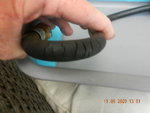Deleted member 86613
Guest
Off
Well it is generally the gas that causes explosions not liquid so personal choices on what you think they will doSo what about Safefill bottles as they are made to rupture in case of a fire to stop them blowing up.
But if they rupture does it not turn to gas. Might sound a daft question, but I presume that if an impact cracks a safefill bottle I thought as liquid is released it would turn to gas and not run out as liquid. If you get my meaning.Well it is generally the gas that causes explosions not liquid so personal choices on what you think they will do
Gaslow R67Interesting, which bottles do this?
It is called a BLEVE, Boiling Liquid Expanding Vapour Explosion. They can be devastating.
I found out about this on my ADR Hazchem course , and yes, it was one of the questions asked in the theory test

A little while ago I turned on my compressor and noticed it didn't cut out when up to pressure - so checking along the long rubber air hose on one of the outlets I found a section just like that in your photo. Looked fine visually while straight but could just hear the air leaking out. And on bending it the cracks became obvious. That hose was maybe in place just 6 years and inside at the point.I checked gas supply hose on one of my old vans and if you accept that you cant really see this fault until you remove the hose the pic may be of benefit to others to check the expiry date on the hose
I always go refillable with stainless hoses which is probably why it was spotted
View attachment 90286
And i do leave gas on generally really dont like putting this on show but it might help others with rubber hoses
Off no questionI know some motorhomes have a recommendation that Gas should be turned off at the bottles when on the move. And others say it is ok to leave on as they have some system or other that permits the gas to be left on.
How do you know which 'class' your motorhome sits in?
What would be the recommendation for a 2008 Autotrail?
You are totally ignoring the plain simple fact that some systems are designed and approved for use whilst driving.1. Gas can escape 'slowly 'as well as 'excessively'.
2. You have absolutely no idea what is going to break/rupture/snap/fall of/come adrift in the event of an accident.
3. What the insurance company thinks, does or otherwise is of no consequence when you are trapped in and the whole thing goes 'whomph'.
Just turn the @@**""g bottles OFF!
